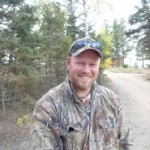LISTEN TO THE PODCAST HERE:

Welcome to another episode of Whitetail Rendezvous. This is your host, Bruce Hutcheon. And we’re going to head to Illinois today. Yes, we’re going to go smack-dab in the middle of Pike County, and we’re going to talk to James Halliday, but otherwise known as Jimbo. And he works with Eagle Lakes Outfitters.
Jimbo, welcome to the show.
Jimbo: Thank you, Bruce.
Bruce: Okay, you’re right in Pike County. Tell us all the wonderful things about all those wonderful bucks we hear about coming from Pike County.
Jimbo: Oh, Pike County, Illinois, is a whitetail buck hunter’s heaven. We’ve got all kinds of rolling hills, wood mix, crop fields, corn, soy beans, wheat, timber, bluffs, rivers. It’s a whitetail’s dream, it really is. And I understand now why big bucks go here.
Bruce: Now, I understand that Pike County is either one or two in the nation with Buffalo County and some places in Kentucky and other places throwing in some mighty fine Pope & Young and Boone & Crocket bucks. But what makes Pike County so special?
Jimbo: I would say it’s mostly the people. The people are friendly, they welcome you. And then on top of that, the deer hunt. The specialty about it is the number of deer that you see when you’re sitting in stands. You can see anything from 5 to 10, all the way up to 50 deer. And the buck-to-doe ratio has been outstanding lately.
Bruce: So how does Pike County grow trophy-class bucks?
Jimbo: I’ve been told Pike County is the center of the whitetail range, where the southern bucks with the wide, massive antlers meet the northern bucks with the huge body. They have massive racks in the north. So you get a combination of the two, and you just have an explosion of world-class whitetail. You get the wide, massive racks on a huge-bodied whitetail. It’s just the center of the whitetail universe. With the crops, all the genetics, all the feed, it’s just easier to grow really giant whitetails.
Bruce: Talk to us about the total acres that you guide on and you hunt on, and how you prepare that for a hunting season.
Jimbo: Okay, Eagle Lakes has between 10,000 and 15,000 acres that they either own or lease. I guide on about 1,200 to 1,500 acres myself. There’s six of us. When we find the property, we’re allowed to go in, do all our scouting, put up trail cameras, put in food plots. If we own it, then we plant our crops. If we lease it, the farmer plants his crops.
But we’ll pick the water sources, the food sources, and get ready to set up treestands mid-August. Of course, the hottest part of the year. So then, we have them up and ready in plenty of time. The scent’s gone by the start of the season in October on.
Bruce: What determines where you set up your treestands?
Jimbo: I set them up according to the bedding, from the bedding area to the food source. I try to get on the trails in between the two for the rut season. For early season, I’ll have a few other food sources around the food plots, on the crops, field edges. So the early season leaves me the pattern. But once the rut starts, I like to get down in the travel corridors, deeper in the woods where the bucks are cruising, looking for the does. Close to water, close to cover, they just don’t like to get out in the middle of the field, if they don’t have to.
So I try to get into cover. I love to try and find a evergreen tree so you have lots of cover around you when I set up my stands. I like to put them high and in lots of cover so that you actually have a better advantage of not being spotted by the whitetail.
Bruce: What type of treestands do you use? Ladder stands, ground blinds, or hang-ons?
Jimbo: We use a mixture of all three. Our clientele, some don’t like to get very high up in a stand. We’ll put our hang-ons about 20, 25 feet up and some clientele won’t go that high, so some will prefer the safety of the ladder stands. And then some of the crossbow hunters or elderly hunters will prefer a ground blind.
So ground blinds we’ll put more on the food sources, along the trails that the bucks are using to come out, or to check. The hang-ons and the ladder stands, we’ll put where we scout, find out that it’s the best location to put them. And if we have to move them because of the client’s seeing something them, we’ll move them for them.
